by Brian Hioe
語言:
English
Photo Credit: Historical Photograph
The Need to Combat Historical Amnesia Regarding the 228 Massacre
ON THE 71ST anniversary of the 228 Massacre, it bears keeping mind that the time from now in which the last surviving individuals that lived through the 228 Massacre will no longer be with us. Once the last 228 Massacre survivors pass away, then the event will become one which no living individual experienced. At this point, the 228 Massacre survivors which are still with us are those who were very young when the killings took place.
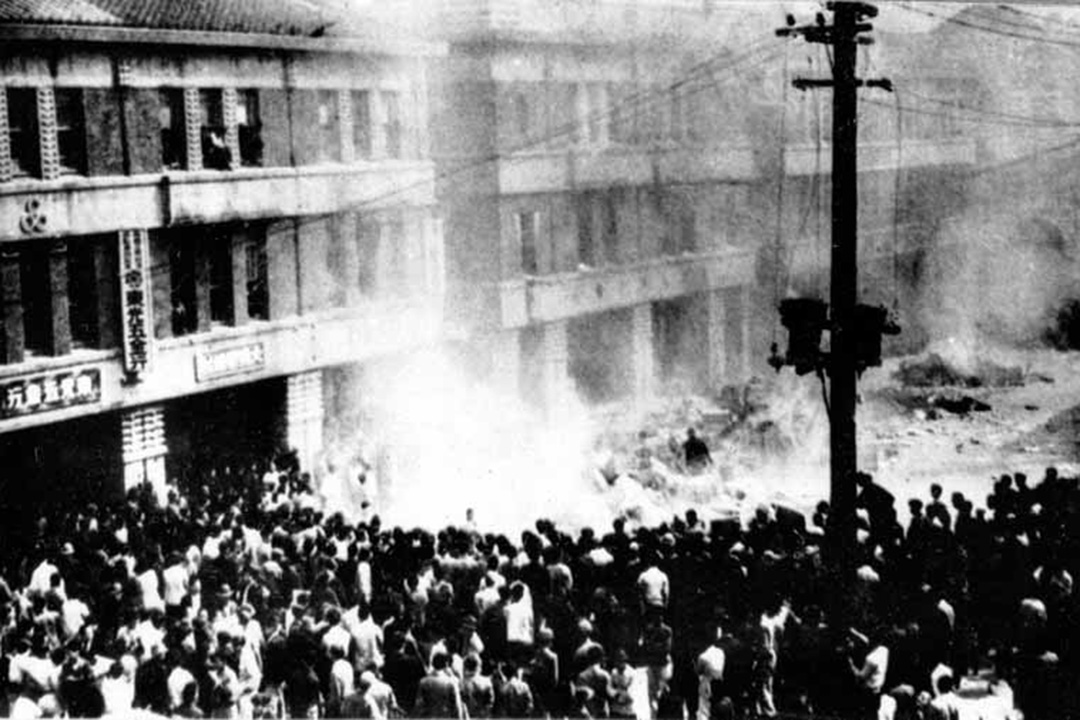 An angry crowd occupying the Taipei branch of the Bureau of Monopoly in demonstration against the killing which sparked the events of the 228 Massacre on the morning of February 28th, 1947
An angry crowd occupying the Taipei branch of the Bureau of Monopoly in demonstration against the killing which sparked the events of the 228 Massacre on the morning of February 28th, 1947
It is as such that historical preservation efforts for the 228 Massacre are more important than ever. The accounts of remaining 228 Massacre survivors must be preserved before they pass away and relevant historical materials related to the 228 Massacre must be made fully public, for historical researchers and others to examine.
The 228 Massacre was an event which greatly shook Taiwan when it took place in 1947. In the killings which followed, the beginning of the KMT’s White Terror, tens of thousands died. Most non-waishengren families in Taiwan lost a family member or knew someone who had been killed.
And the lingering scars of the White Terror run deep. Many Taiwanese families continue to be able to point to how they were affected by the White Terror. For those that are still alive, frequently unable to fully communicate with their children and grandchildren due to the KMT’s restrictions on Taiwanese and Japanese, the effects of KMT authoritarian rule are still readily visible. Yet at the same time, one cannot underestimate the power of historical amnesia.
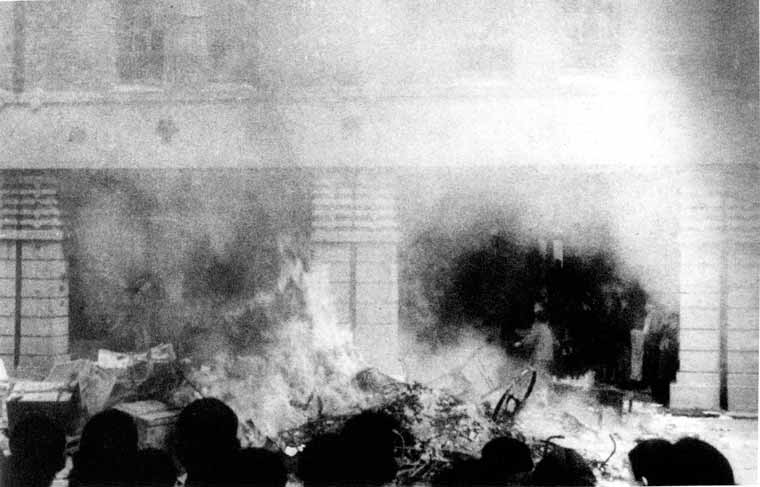 Yidingmu police station being stormed on 228
Yidingmu police station being stormed on 228
Writing on the Holocaust and reflecting on the impossibility of representing historical tragedy on that scale, the theorist Theodor Adorno once wrote that there could be “No poetry after Auschwitz.” But unfortunately, historical memory proves a short thing, as one sees in the contemporary phenomenon of neo-Nazism globally, as dramatically visible in openly fascist supporters of Donald Trump that rose to prominence in the past year, including as appointees within the Trump administration. What is striking is that these are often young people who precisely come to identify with the symbols of Nazism, in the case of America, claiming to be nationalists of a country that went to war with Nazi Germany, likely because they never experienced actual existing Nazism in their lifetime. The dangers of historical amnesia, then, can never be underestimated, particularly concerning the next generation.
Continued Historical Denial by the KMT
THE KMT SEEMS to understand something of the power of historical amnesia in contemporary efforts to deny that the 228 Massacre ever occurred. Namely, the KMT believes that it can cover up its past crimes during the 228 Massacre and White Terror if it stamps out the historical memory of the 228 Massacre, since increasingly few people who directly experienced the 228 Massacre are still alive.
Attempts by the KMT to deny the historical existence of the 228 Massacre are longstanding. During the Ma administration, the government indirectly funded research for pan-blue academics such as Chu Hung-yuan to claim that only 800 individuals died during the 228 Massacre, and that the uprisings against the government which followed were orchestrated by the Chinese Communist Party. More recently, in the past week, the deep blue Blue Sky Action Alliance, for example, organized an exhibition of historical data with the aim of clearing the KMT from wrongdoing. Such individuals claim that the 228 Massacre has been greatly exaggerated by the DPP with the aims of slandering the KMT and that Chiang Kai-Shek should be exonerated of blame. High-ranking KMT politicians such as Alex Tsai have in similarly attempted to deny the facts of 228, claiming that there was no photographic evidence of any killings and, in this way, suggesting that they never took place or have been greatly exaggerated.
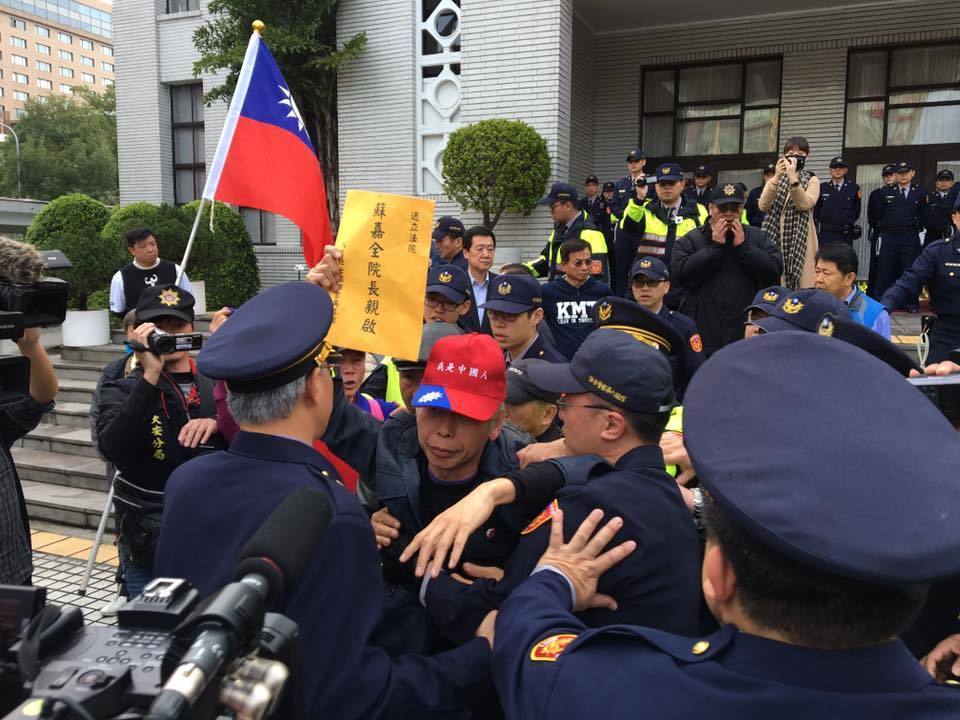 Members of the “800 Soldiers” clashing with police yesterday. Photo credit: UDN
Members of the “800 Soldiers” clashing with police yesterday. Photo credit: UDN
In the meantime, the KMT demonstrates that it does not take past wrongdoing seriously, with coordinated demonstrations yesterday by KMT legislators on the legislative and attempts by the “800 Soldiers” group outside the Legislative Yuan to force their way into legislature. These demonstrations were coordinated to take place one day before the commemoration of the 228 Massacre.
The “800 Soldiers” is a group of retired pan-Blue military veterans, public servants, and teachers—although mostly military veterans—protesting the Tsai administration’s planned pension reforms. Members of the military, public servants, and teachers were paid generous pensions under KMT rule, as a kickback for political loyalty. The Tsai administration is attempting to cut back on their pensions because this will bankrupt Taiwan’s pension system, something which the “800 Soldiers” claim to be political persecution against them. This is in spite of that in many cases, their pension rates mean that in many cases they continue to be paid more than many in Taiwan make per month in retirement—particularly young people—and members of the “800 Soldiers” include individuals who were literally enforcers of martial law under the KMT.
In general, with pension reform efforts by the DPP, attempts to release historical documents regarding the White Terror and 228 Massacre, transitional justice legislation aimed at addressing past crimes committed during the martial law period, and efforts to cut back the KMT’s party assets from property seizures that occurred during the authoritarian era which it retains into democratization, the KMT claims this to be a form of political persecution. In particular, the KMT alleges that this is a “Green Terror” “a hundred times worse” than the “White Terror.”
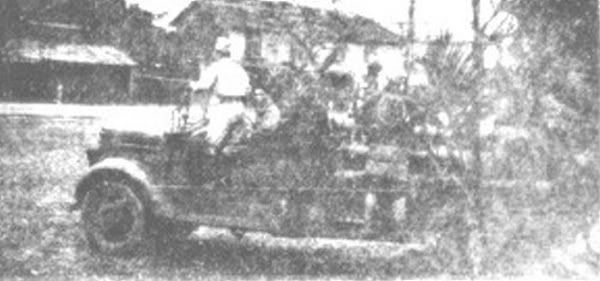 Machine gun reportedly seen installed in a fire engine occupied by KMT troops seen during the 228 Massacre
Machine gun reportedly seen installed in a fire engine occupied by KMT troops seen during the 228 Massacre
But apart from the irony that these are simply attempts to to deal with unresolved legacies of the martial law period, this also demonstrates how little the KMT remembers its past crimes from the 228 Massacre or during the White Terror. If it is the case that, as the KMT claims, there is a “Green Terror” currently ongoing, where is the vast mountain of dead executed by the Tsai administration since it took office? Considering that the KMT killed tens of thousands during the White Terror, if there was a ongoing “Green Terror” “a hundred times worse” than the “White Terror”, by now there should be millions of corpses. If, indeed, it proves impossible to confirm the 228 Massacre because of lack of photographic as evidence, as Alex Tsai claims, there certainly do not seem to be any photos of such mass killings—something that should be quite easy to provide in the age of the smartphone.
And while the “800 Soldiers” have been among the most vocal in 228 denialism, it is young and old alike that engage in historical denialism in the pan-Blue camp. One observes this in demonstrations last month by members of the KMT Youth Corps outside of a talk by Rainer Eppelmann, head of the government-funded Federal Foundation for the Study of Communist Dictatorship in East Germany, on the experience of transitional justice in Germany. Members of the KMT Youth Corps held signs stating “Sincerely Suggest that you do NOT be fooled by DPP, which is the living example of dictatorship” [Sic], claiming that “Taiwan is the Democratic Light House of Asia, which is leaded by the KMT” [Sic], that the “KMT is Anti-Communism, KMT is Anti-Dictatorship,” [Sic] and that “KMT leaded Taiwan to fight for freedom for seven decades” [Sic].”
Such sentiments evidence further historical denial of the KMT’s past crimes and, on the contrary, attempts to pin accusations of dictatorship upon the DPP, which emerged from Taiwan’s democratic movement.
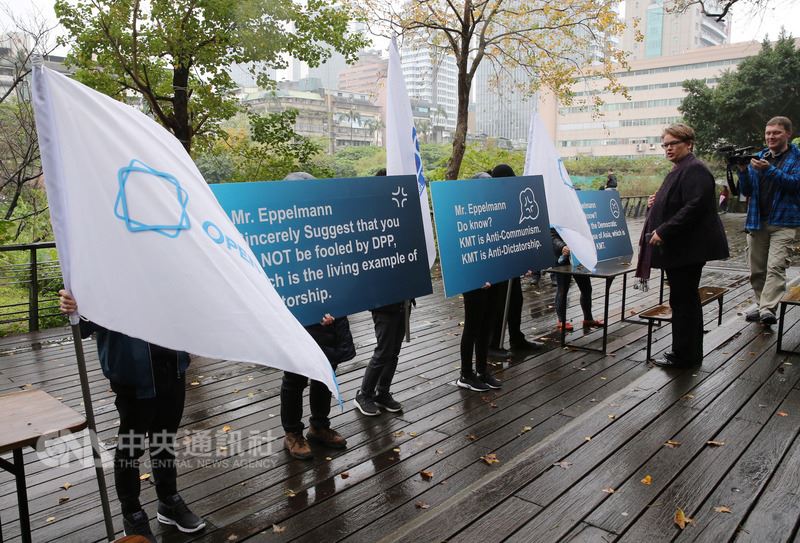 Members of the KMT Youth Corps demonstrating outside of a talk by Rainer Eppelmann last month. Photo credit: CNA
Members of the KMT Youth Corps demonstrating outside of a talk by Rainer Eppelmann last month. Photo credit: CNA
Accusations of political persecution against the DPP by New Party spokesperson Wang Ping-chung ring similarly, after Wang was detained for questioning because of Wang being involved in running a China-sponsored media outlet aimed at spreading pro-China views in Taiwan with the aim of building an espionage ring or even a paramilitary cell, according to some accusations. Despite that Wang could be accused of treason and would have, in fact, been probably quickly executed in secret during the authoritarian period as a communist turncoat by the KMT, and that Wang was eventually released—and even allowed to publish an editorial in China’s state-run Global Times—Wang still saw fit to accuse the DPP of authoritarian behavior.
An Unusual Hesitancy by the DPP on Transitional Justice Efforts
IN THE MEANTIME, it also remains necessary to continue to push the DPP on the matter of realizing justice for 228 Massacre and White Terror victims. While the DPP-led government declassified all 228 Massacre-related documents, the DPP does not wish to rock the boat too hard on the issue of the White Terror, seeing as many of the perpetrators of the White Terror are still alive and some continue to serve in government positions or are active figures in Taiwanese political life. No less than James Soong, the former head of the Government Information Office and an individual directly responsible for persecution of political dissidence, remains an active government politician, even serving as Taiwan’s representative to APEC twice under the Tsai administration. On the other hand, most 228 victims and most perpetrators of the 228 Massacre are safely dead.
Namely, the DPP indeed fears being accused of political persecution, leading to charges that it has proven similarly undemocratic as the KMT. But at the same time, in line with the general conservatism of the Tsai administration, the DPP has also claimed that it will be “discreet” in naming even the perpetrators 228 Massacre. And so one has little hopes for the DPP to do much more than token gestures when it comes to resolving the unresolved legacies of 228 Massacre beyond measures such as, for example, giving certificates of recognition to 228 Massacre survivors.
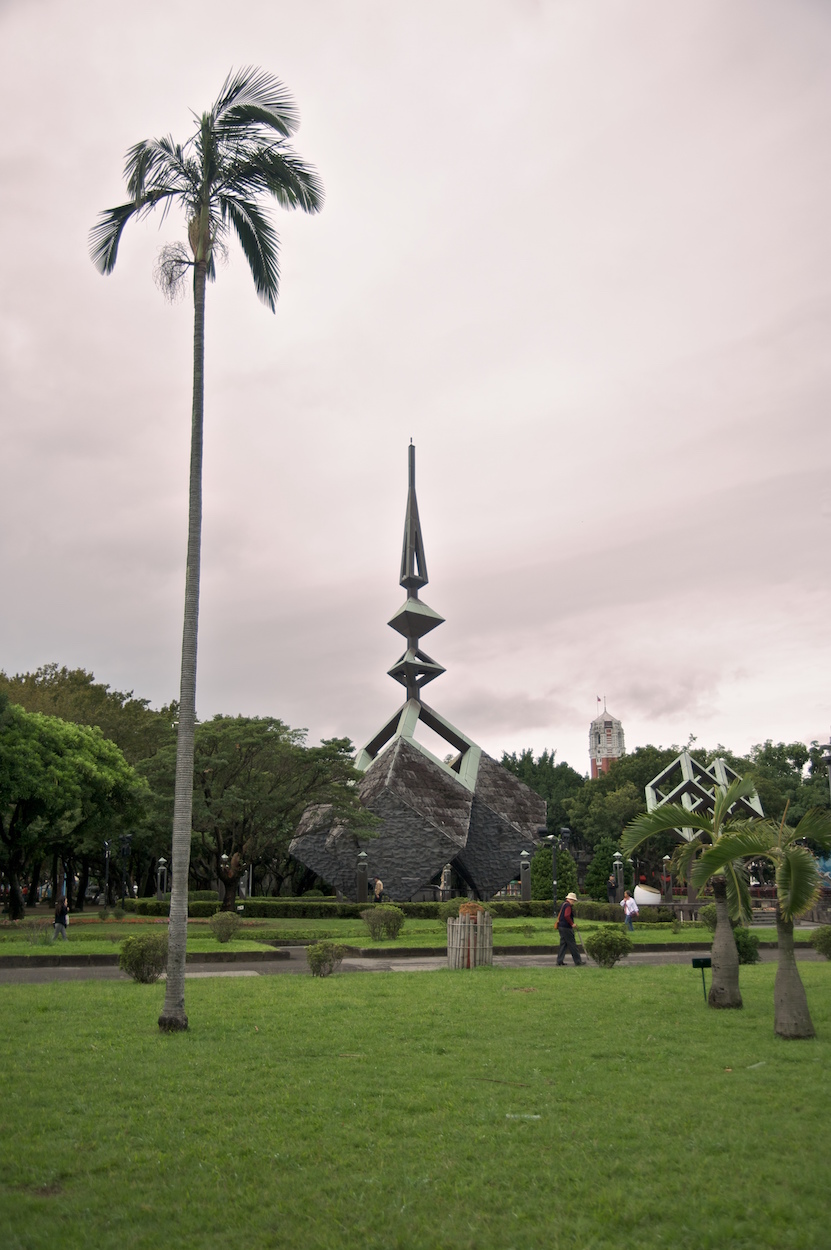 228 Memorial Park. Photo credit: Fred Hsu/WikiCommons/CC
228 Memorial Park. Photo credit: Fred Hsu/WikiCommons/CC
It may ultimately depend on Taiwanese civil society to push for justice for 228 Massacre and White Terror victims to be realized then. And so the tasks facing Taiwanese society are twofold. First, remaining accounts of surviving 228 Massacre victims need to be documented to preserve them for historical memory. Second, efforts are still needed to push for justice for 228 Massacre victims—and hopefully this will occur while they are still alive. In this respect, the path to be walked for transitional justice in Taiwan remains a long one.

